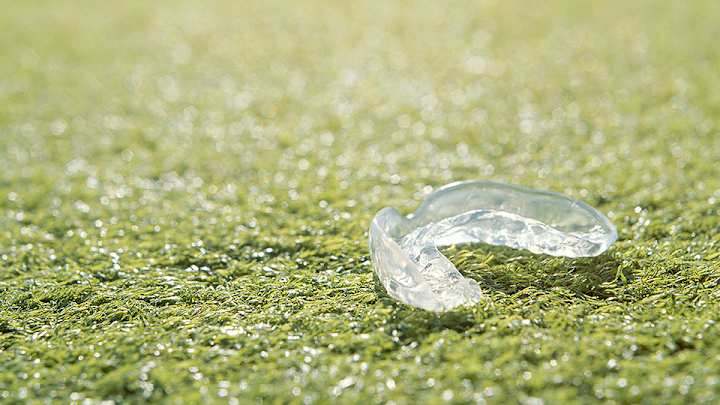Football mouthguards of tomorrow will detect dehydration, head injuries

By Jeff Beckham, WIRED
The humble mouthguard—that C-shaped piece of plastic that protects an athlete’s teeth—has remained relatively unchanged for the past 60 years. But today, the most unassuming part of a football player’s gear is poised for a technological makeover that would place it squarely in the middle of the most important phases of the game.
Mouthguards won’t look too different from the outside, but they may soon gain the ability to help assess head injuries, tell you when you’re becoming dehydrated, or even transmit instructions directly from the sideline.
One advantage that mouthguards hold over other gadgets is their location—they’re quite literally inside your head—which puts them in proximity to a lot of useful information.
“That unique, but not overly intrusive placement, allows for some interesting use of sensors,” said Will Carroll, a sportswriter who specializes in covering medical issues. “In addition, they're quickly accessed. As sensors get more ubiquitous and small, I think this is going to only see more innovation.”
Athletes would have to get used to the idea of putting something in their mouth that’s filled with accelerometers, batteries, and antennas. But a trio of companies are showing that the possibilities are remarkable.
Look for new entries in the Super Bowl 100 series, presented by Gatorade and Microsoft Surface, at SI.com/SB100 and Wired.com/SB100
Chapter 1, Oct. 7 TRAINING
Chapter 2, Oct. 28 EQUIPMENT
Chapter 3, Nov. 18 STADIUMS
Chapter 4, Dec. 9 CONCUSSIONS
Chapter 5, Dec. 16 MEDIA
Chapter 6, Dec. 30 VR
Chapter 7, Jan. 6 NFL IN SOCIETY
Chapter 8, Jan. 13 TRACKING
Chapter 9, Jan. 20 STRATEGY
Chapter 10, Jan. 27 SB 100
ROAD MAP TO
THE FUTURE
For the most pressing medical issue facing the NFL today—head injuries—a mouthguard acts as an early warning system. The Vector mouthguard, from i1 Biometrics, measures how the skull moves as a result of an impact. Here’s how it works: Your upper jaw moves wherever your skull moves. The Vector measures those forces and sends that data to trainers on the sidelines. That information, while not enough for a concussion diagnosis, gives a team’s medical staff another tool to determine whether to keep a player in the game.
The Vector is available now for $199, and members of the LSU Tigers have been wearing the mouthguards this season. Other colleges, including Texas A&M and the University of South Carolina, have tested the technology.
While i1 Biometrics CEO Jesse Harper spent years in the fitness monitoring business before opening his own startup, other companies in the same space have more unlikely leaders. Dana Hawes is an Army veteran and school principal who was hit with inspiration after watching LeBron James cramp up during Game 4 of the 2012 NBA Finals. As James pulled out his mouthguard and staggered to the bench, Hawes, a huge Miami Heat fan, was moved to learn how this could happen to one of the world’s best athletes at such a crucial time.
Hawes’ research led him to found SMRT Mouth, designed to track hydration levels and signal when it’s time for a water break. The scientific principle behind the device is called osmolality, or the measure of how much one substance has been dissolved in another. SMRT Mouth’s readings of the osmolality of saliva can determine how hydrated you are. By also tracking your pulse, the device can look for changes in heart rate, along with variations in respiration and exertion. That data connects with a smartphone app to provide alerts when you’re nearing your limits.
“There are some 120 biometrics markers that can be tracked in the mouth,” said Hawes, who expects SMRT Mouth to ship within the next year. “So if you inundated users with 120 data points and the app wasn’t sophisticated and streamlined, you wouldn’t have a good experience and wouldn't fare very well.”
The project grabbed the attention of former Pro Bowler Michael Robinson, who signed on as SMRT Mouth's president. Robinson, who won a Super Bowl with the Seattle Seahawks, has his own history with dehydration. He missed several weeks of the 2013 season when he became dehydrated after taking an anti-inflammatory drug, and back in high school in 2000, a teammate of Robinson’s collapsed and died of heat stroke.
One day, mouthguards may go beyond protection and health uses to something even more unexpected: communication. At MindTalk, co-founders Nick Fragnito and Rob Burke created a mouthguard that uses the principle of bone conduction to transmit music to the listener. Sounds can be sent to the inner ear via the bones of the skull—it’s a common feature of headphones and it’s part of what allowed Google Glass wearers to hear sounds without broadcasting them to the outside world.
MindTalk took the idea a step further with the addition of a tiny radio transmitter, so that the mouthguard then becomes a way to receive signals from coaches. The Dallas Cowboys and Dallas Stars have expressed interest in testing prototypes and the company expects a version of the mouthpiece to go on sale next year as a music player.
From a simple polymer that protects your pearly whites to a device that allows you to hear voices inside your head, the mouthpiece may turn out to be the most unlikely piece of equipment to find its spot in the future of football.
